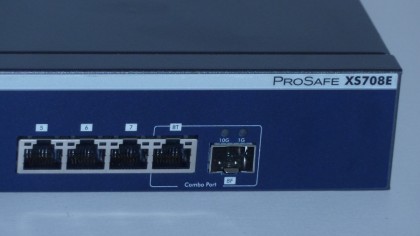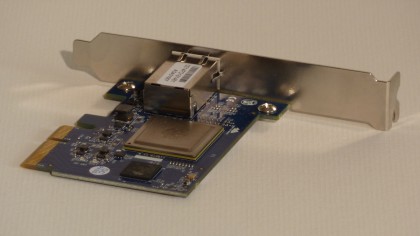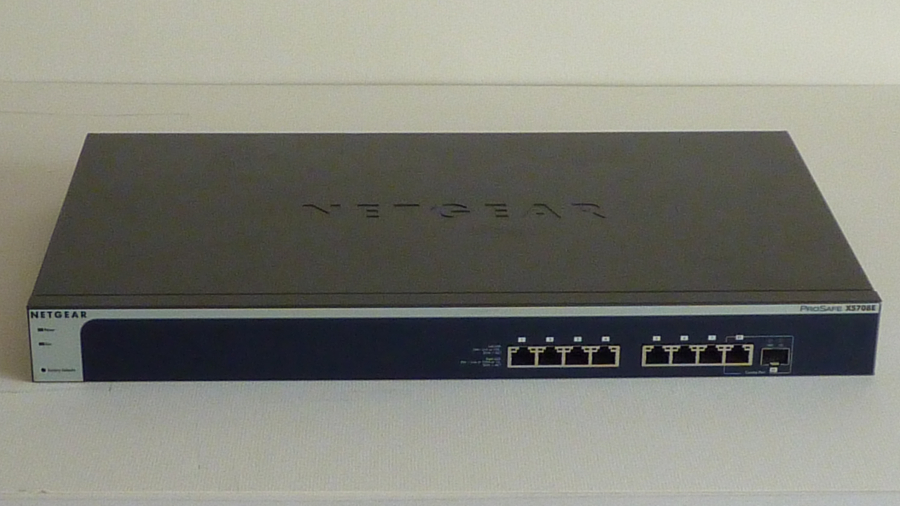Why you can trust TechRadar
The Netgear ProSafe XS708E is an unmanaged 10GbE switch, with eight auto-sensing, auto-negotiating 10GbE RJ45 ports and a single SFP+ combo port for fibre connections. That means that when the SFP+ port is in use, one of the RJ45 ports is disabled.
In keeping with every other Netgear switch, it comes with a dark blue metal chassis. It's 1U high, with dimensions of 43mm x 330mm x 207mm, weighing 3.6kg. Although Netgear sent me a unit in a plain box rather than a full retail package, a rack mount kit is bundled with it.
There are LEDs galore on the front. There's one to indicate power status, one that lets you know about a fan failure, and each port has two to show link connection – green for 10GbE, amber for standard Gigabit speeds.
Netgear sells units with a larger number of ports too. You can get the XS712T, which has 12 RJ45 ports and two SFP+ ports, for example. The XS708E is powered by a Broadcom BCM56822 SoC, with 256MB of DDR2 memory, but the larger switch has a faster processor.

Fan noise
The unit is physically larger than a typical unmanaged desktop Gigabit switch, reflecting the higher demands of 10GbE. Whip the cover off and you'll see large heatsinks covering the interconnects, drawing heat to the metal chassis. It also has two 40mm fans that initially spin loudly when the switch is turned on, and continue to emit a noticeable hum when the unit is in use, quite clearly because the sheer volume of data and the additional power it requires will increase heat levels inside the unit. Not a problem in a server room, but not much fun for home users.
While the XS708E fits into the unmanaged switch category, Netgear offers some Windows desktop software to configure it. While it's not the most beautiful or user-friendly application, it works okay, automatically detecting any Netgear switch on the network, presumably via its MAC address.
There's no web interface to log into so this management has to be done from a Windows PC only. When you click on a device the software confronts you with a login screen, with the required password printed on the underside of the switch. Here, you can configure software functions more usually found on routers. VLAN support, QoS and denial of service protection are there.
The software can also indicate whether there's a problem with any of the ports, showing their link status at a glance. There's also a cable testing function, which could be very handy for use in a crowded server cabinet with hundreds of network cables and a port that's playing up.
One of the neatest software features is built-in Port Trunking, or link aggregation (LAG). Two physical Ethernet connections can be combined into one, for extra resilience and load sharing. However, the configuration options are rudimentary. You create a LAG group, and that's it. No other settings are available, which could be why we ran into issues when testing certain NAS units with it.
However, a small but particularly lovely aspect of the XS708E is a lifetime warranty, with next-day replacement. This applies not just to the US market, but a list of other European countries, including the UK, as well as Australia and New Zealand. Good one, Netgear!

Thecus C10GTR card
The Thecus C10GTR is a good example of how 10GbE hardware is becoming more affordable. It's a low-profile 10GbE card, with a standard RJ45 connector. It fits into a full-sized PCI-Express slot rather than a short X1 slot, since it requires at least four lanes (X4) to provide the required bandwidth.
It's really short, and space on its PCB is mostly occupied by the Tehuti TN4010 processor that does the grunt work blasting all those bits between your server and network.
In fact, it's so small, you might feel short-changed after handing over £300 ($392, AU$450) for it, but it's worth remembering what its job is – squeezing ten times as much data as Gigabit Ethernet down a single cable, reliably. Prices have come down considerably too, so while it's not cheap enough yet to be included on consumer motherboards, it's all headed in the right direction.
As one would expect, the C10GTR is fully backwards compatible with older networking standards that use RJ45 connectors.
The card draws 4.95W when operating at 10GbE speeds, slightly less than some older cards which hover around 6W. This drops to 3.3W when used at Gigabit speed. Jumbo Frames of 16K are supported, as well as 802.3ad Link Aggregation.
There's also excellent driver support that reflects modern software environments. In addition to the typical offering of Windows 7, Windows 8, Windows Storage Server 2012, and 2008 R2, there's Linux, VMWare 5.5 and Hyper-V support.
Current page: XS708E setup and Thecus C10GTR
Prev Page Introduction and cost issues Next Page Performance